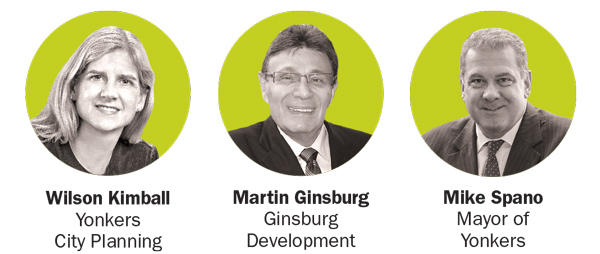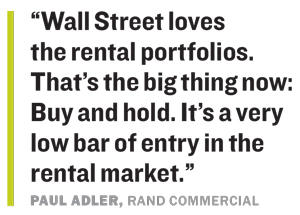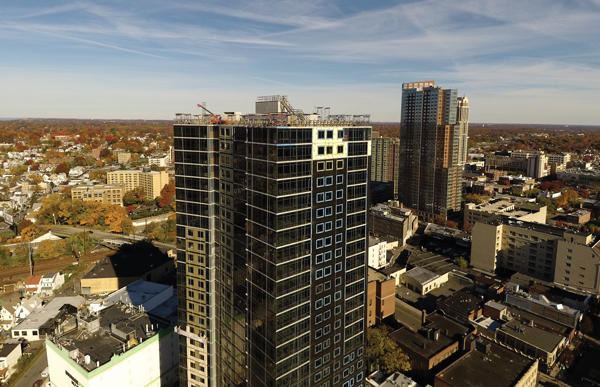Westchester County is playing catch-up.
“We’ve really had very little development over the last 20 years,” said Martin Ginsburg, founder of Ginsburg Development Companies and one of the county’s most active developers. “From a luxury apartment point of view, there has been almost nothing.”
That’s rapidly changing. Dozens of large multifamily projects — especially in the lower and central parts of Westchester closer to New York City — are currently under construction or being planned. Developers pursuing projects in Brooklyn, Queens and Manhattan had bypassed Westchester for years, Ginsburg said. But now a flood of inventory is teed up and ready to roll out.
According to the Marketing Directors, a development advisory firm, in the next three years 2,255 rental units are scheduled to come online in Westchester, the bulk of them in New Rochelle and White Plains. (Those numbers include only units under construction and not yet available for lease or sale.)
In a recent month-long period, Westchester had 870 rentals available, the bulk of which were in Yonkers, New Rochelle and White Plains, according to numbers provided by Paul Adler, chief strategy officer at Rand Commercial. Adler said multifamily developers in the county have been spurred on by financial incentives provided by the Westchester Industrial Development Agency and other municipal IDAs.
“The realized savings from the IDA as to tax abatements, no mortgage recording taxes [and] sales tax exemptions can make the difference of building or not [building],” he said.
Bridget Gibbons, director of the Westchester County Office of Economic Development and head of the county’s IDA, said about $49 million in tax incentives were given to developers in 2018, which resulted in $881 million in private investment for new projects. Gibbons said such enticements are necessary for Westchester’s future.
“We need an influx of talent into the county, but we had a dearth of rental units for their housing,” Gibbons said. “Not everyone wants the big house in Armonk. We’re seeing a lot of people who have been priced out of the city … The prices are lower here.”
Adler, who has an office in White Plains, cited the relatively low cost of doing business in Westchester as one reason why it’s become popular for developers. “You can build stick [wood] buildings under four to six stories and be all in for under $200 per square foot,” he said. “In [New York City] there is no such option these days.”

High-rise rentals in Westchester cost developers in the range of $300 per buildable square foot, said Adler, noting that similar projects in New York City can reach $400 to $500 per buildable square foot. For Manhattan developers building ultraluxury condos, that number can reach $1,000 per square foot, Adler said. That extra financial “elbow room,” as well as Westchester’s highly educated and mobile workforce, is what he believes is giving the county’s building boom legs.
“Business follows residential,” he said. “Wall Street loves the rental portfolios. That’s the big thing now: Buy and hold. It’s a very low bar of entry in the rental market.”
Developers and municipalities are now banking on affordable apartments near train stations in walkable communities to draw in millennials. Such projects can be found scattered across Westchester in places like Harrison, Hastings-on-Hudson, Mamaroneck, Mount Vernon, Peekskill, Pelham, Sleepy Hollow and Rye Brook.
Homebuilding giant Toll Brothers, for example, is redeveloping a 70-acre former General Motors assembly plant in Sleepy Hollow dubbed Edge-on-Hudson, a mixed-use project now in its first phase. Still, the bulk of Westchester’s multifamily activity remains in three cities. Below is a closeup on each of those locations.
The New Rochelle niche
Of Westchester’s cities, New Rochelle might be the most aggressive in reinventing itself as a haven for millennials, along with their empty-nester parents and grandparents. The city has created a bike-sharing program and installed Wi-Fi kiosks and Soofa benches — with embedded solar-powered charging stations — around its downtown.
Last year, it also adopted an accelerated 90-day approval process to attract developers, and it now has about 20 projects greenlit with a total of 3,500 units coming online.
In addition, the city has tapped RXR Realty and Renaissance Downtowns to develop 12 million square feet of real estate as part of a downtown master plan that includes 6,370 residential units. The goal is to attract 20,000 new residents in the next decade, bringing its population to 100,000.
 New Rochelle Mayor Noam Bramson said RXR has the “exclusive opportunity to develop several publicly owned [downtown] parcels that include about a dozen acres.”
New Rochelle Mayor Noam Bramson said RXR has the “exclusive opportunity to develop several publicly owned [downtown] parcels that include about a dozen acres.”
Seth Pinsky, an executive vice president and investment manager at RXR, said that the firm’s agreement with New Rochelle works because “there is a need for more multifamily inventory throughout the region.”
Pinsky said RXR is providing that inventory in Westchester’s downtowns “at rents that are a fraction of what is charged in New York City, including prime outer borough neighborhoods.”
Despite the number of projects underway and the amount of inventory coming online, Pinsky predicted that RXR’s units will lease at a “healthy rate.” He reasoned that renters from Manhattan and elsewhere are “looking for an urban lifestyle,” cheaper rents and mass transit connectivity to New York City. Demand will also come from existing Westchester residents looking to downsize from single-family homes to apartments with modern amenities, he said.
The company is currently developing a market-rate, mixed-use development on Church and Division streets that will consist of twin 28-story towers on the site of a former parking garage. It will also start leasing this spring at 360 Huguenot, a 28-story, 280-unit mixed-use building on the site of a former Loews Theater that will include a 10,000-square-foot black box theater and a blank canvas for film, theater, dance, music and art programs.
Frank Chechile of Rye-based CAC Realty, which is developing the Huguenot, a 60-unit building at 387 Huguenot Street, said “all of this development shows the confidence of developers and investors.”
“We’re investing our own capital,” he said. “This shows the confidence we have in what’s going on in New Rochelle.”
Expected rents at the Huguenot, CAC’s first development in New Rochelle, range from $1,500 to nearly $3,000 a month, rates that Chechile said are typical for new buildings in the area.
New Rochelle’s Garden Street will see two major developments rise in late 2020. Bronx-based developer the Stagg Group is planning a 187-unit, 14-story mixed-use building there, where at least 19 units will be affordable housing, per Westchester guidelines. And RXR is erecting another mixed-use development on the stretch where all 219 units will be affordable.

RXR Realty’s 360 Huguenot in New Rochelle
Despite the increase in high-rise construction, many new buildings in New Rochelle — such as the Huguenot, the Printhouse, the Millennia and NewRo Studios — are no more than six stories. And to that end, Bramson isn’t worried about overdevelopment.
“While the number of new units is significant relative to New Rochelle’s population, it’s a drop in the bucket for the New York metropolitan area,” the mayor said. “We have every confidence that demand for our new housing is strong.”
Yields in Yonkers
To put it simply, Yonkers is going bonkers. The city, which has a population of just over 200,000, now has more than 5,000 rental units completed or in its pipeline, said its commissioner of planning and development,Wilson Kimball.
That includes more than 1,000 new units in projects downtown that are either leased up or currently leasing, such as RXR’s 442-unit, two-tower Sawyer Place and Mill Creek Residential’s 324-unit Modera Hudson Riverfront, Kimball said, along with another 459 apartments in northwest Yonkers.
Other developments include two Stagg Group projects with 204 units and a 609-unit project from AvalonBay on the Yonkers waterfront, said Kimball, who noted that another 2,112 units have not even broken ground yet.
Yonkers Mayor Mike Spano said most of the building has taken place on empty properties and brownfields. “We’re not displacing anybody here,” he said. “We took these empty properties and put real money there.”
In addition to RXR, other major Manhattan developers are also getting in on the action. Extell Development has the Extell Hudson Waterfront, a seven-building, mixed-use project that will include 1,395 residences, 48,280 square feet of commercial space and more than 1,500 parking spaces. Yonkers’ IDA has approved $21 million in tax breaks for the $502 million development.
In October, Manhattan-based AMS Acquisitions paid $16 million for a six-acre parking lot on Chicken Island — the site of a former slaughterhouse — with plans to build a mixed-use residential center and luxury hotel. Spano said Yonkers had been trying to develop the downtown parcel for more than 40 years. AMS, which is already developing two other Yonkers waterfront properties, paid $18.3 million in November for a 50,000-square-foot downtown lot where it plans to build a 24-story building with 361 units.
“We’ve financed it with private capital. We feel that to have waterfront property within 25 minutes of [Grand Central Terminal] at these prices is very compelling,” said AMS managing principal Michael Mitnick.
“It costs less to buy the land and build, and the yields are higher when you leave the boroughs and Manhattan,” he added. “You don’t have to be in New York City to have attractive neighborhoods.”

Mitnick claimed most of Westchester’s luxury buildings are largely full and that new units coming online are moving quickly.
And Yonkers’ IDA isn’t slowing down. It has approved financial incentives for three major residential projects that will add about 1,000 more new rentals, all of which are awaiting city approval.
Two of those developments — Ludlow Point (520 units in four towers) and 70 Pier Street (36 units) — are owned by Ginsburg, the Valhalla-based developer. The third project is a $177.3 million, 440-unit residential development by Manhattan-based Rose Associates that includes 25,000 square feet of new waterfront open space.
White Plains paradigm
White Plains is a model for Westchester development.
“[It’s] the only city in Westchester that has [an existing] office workforce,” Ginsburg said. “The only thing lacking is luxury housing.”
White Plains has created a new transit zone to attract more mixed-use projects around its Metro-North train station, which is undergoing a $92 million renovation. Ginsburg’s firm unveiled the transit zone’s first development, City Square, in November. The project will transform the Westchester Financial Center, a 571,000-square-foot property that Ginsburg bought last year for $83 million, into 188 rental apartments, retail and restaurant space.
Ginsburg had earlier purchased the Metro, a nearby 122-unit residential building, which completes the block that is City Square. Amenities will include a Club Lounge with a roof terrace, fitness center and 24-7 concierge service. As in Yonkers and New Rochelle, brokers and developers don’t seem overly worried about the surge in inventory.
“Right now, I would say no, there aren’t any concerns about too much inventory,” said Richard Haggerty, CEO of the White Plains-based Hudson Gateway Association of Realtors, which has more than 10,300 members in Westchester, Rockland, Putnam and Orange counties. “The job market is tight, the boroughs are expensive, and a lot of folks are betting that Westchester is a very attractive market.”
AMS’ Mitnick predicted the next wave of Westchester development will be a combination of residential, retail and office space.
Among the city’s newer residential buildings, meanwhile, are the Continuum, a 16-story, 288-unit tower that opened last year. Its developer, Manhattan-based LCOR, is now moving forward with another 16-story residential building. Both properties will include 3,350 square feet of retail, with rents in the completed North Tower ranging from $1,120 to $4,220 a month.
Rand Commercial’s Adler sees mixed-use properties being the next big thing in the area. In a 20-story tower, for example, apartments could cover floors 15 to 20, with one through five being office or co-working space, he explained, and a condo and hotel mix in the middle. If one product takes a hit, a landlord’s other assets within a building can absorb it.
“Mixed-use almost makes it recession-proof,” Adler said. “You need that flexibility.”
